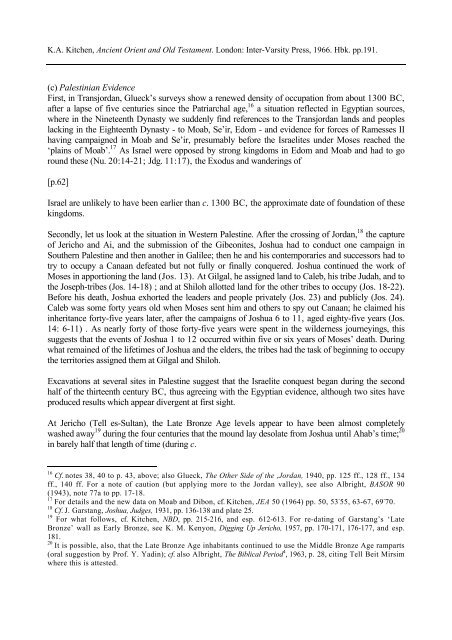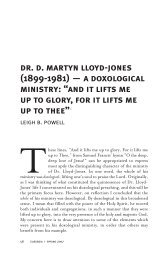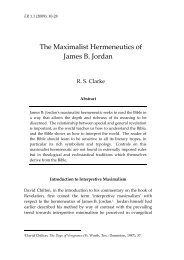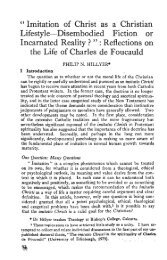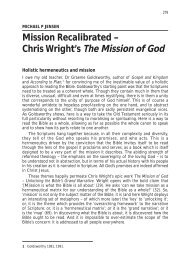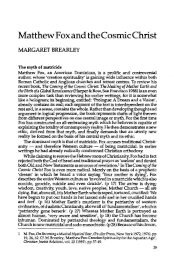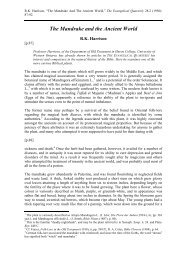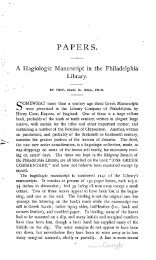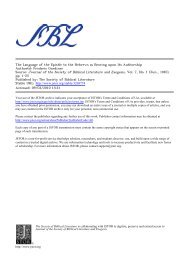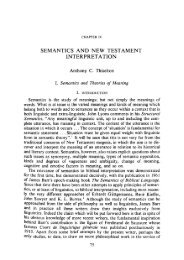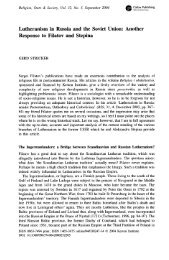Ancient Orient and Old Testament - BiblicalStudies.org.uk
Ancient Orient and Old Testament - BiblicalStudies.org.uk
Ancient Orient and Old Testament - BiblicalStudies.org.uk
Create successful ePaper yourself
Turn your PDF publications into a flip-book with our unique Google optimized e-Paper software.
K.A. Kitchen, <strong>Ancient</strong> <strong>Orient</strong> <strong>and</strong> <strong>Old</strong> <strong>Testament</strong>. London: Inter-Varsity Press, 1966. Hbk. pp.191.<br />
(c) Palestinian Evidence<br />
First, in Transjordan, Glueck’s surveys show a renewed density of occupation from about 1300 BC,<br />
after a lapse of five centuries since the Patriarchal age, 16 a situation reflected in Egyptian sources,<br />
where in the Nineteenth Dynasty we suddenly find references to the Transjordan l<strong>and</strong>s <strong>and</strong> peoples<br />
lacking in the Eighteenth Dynasty - to Moab, Se’ir, Edom - <strong>and</strong> evidence for forces of Ramesses II<br />
having campaigned in Moab <strong>and</strong> Se’ir, presumably before the Israelites under Moses reached the<br />
‘plains of Moab’. 17 As Israel were opposed by strong kingdoms in Edom <strong>and</strong> Moab <strong>and</strong> had to go<br />
round these (Nu. 20:14-21; Jdg. 11:17), the Exodus <strong>and</strong> w<strong>and</strong>erings of<br />
[p.62]<br />
Israel are unlikely to have been earlier than c. 1300 BC, the approximate date of foundation of these<br />
kingdoms.<br />
Secondly, let us look at the situation in Western Palestine. After the crossing of Jordan, 18 the capture<br />
of Jericho <strong>and</strong> Ai, <strong>and</strong> the submission of the Gibeonites, Joshua had to conduct one campaign in<br />
Southern Palestine <strong>and</strong> then another in Galilee; then he <strong>and</strong> his contemporaries <strong>and</strong> successors had to<br />
try to occupy a Canaan defeated but not fully or finally conquered. Joshua continued the work of<br />
Moses in apportioning the l<strong>and</strong> (Jos. 13). At Gilgal, he assigned l<strong>and</strong> to Caleb, his tribe Judah, <strong>and</strong> to<br />
the Joseph-tribes (Jos. 14-18) ; <strong>and</strong> at Shiloh allotted l<strong>and</strong> for the other tribes to occupy (Jos. 18-22).<br />
Before his death, Joshua exhorted the leaders <strong>and</strong> people privately (Jos. 23) <strong>and</strong> publicly (Jos. 24).<br />
Caleb was some forty years old when Moses sent him <strong>and</strong> others to spy out Canaan; he claimed his<br />
inheritance forty-five years later, after the campaigns of Joshua 6 to 11, aged eighty-five years (Jos.<br />
14: 6-11) . As nearly forty of those forty-five years were spent in the wilderness journeyings, this<br />
suggests that the events of Joshua 1 to 12 occurred within five or six years of Moses’ death. During<br />
what remained of the lifetimes of Joshua <strong>and</strong> the elders, the tribes had the task of beginning to occupy<br />
the territories assigned them at Gilgal <strong>and</strong> Shiloh.<br />
Excavations at several sites in Palestine suggest that the Israelite conquest began during the second<br />
half of the thirteenth century BC, thus agreeing with the Egyptian evidence, although two sites have<br />
produced results which appear divergent at first sight.<br />
At Jericho (Tell es-Sultan), the Late Bronze Age levels appear to have been almost completely<br />
washed away 19 during the four centuries that the mound lay desolate from Joshua until Ahab’s time; 20<br />
in barely half that length of time (during c.<br />
16 Cf. notes 38, 40 to p. 43, above; also Glueck, The Other Side of the ,Jordan, 1940, pp. 125 ff., 128 ff., 134<br />
ff., 140 ff. For a note of caution (but applying more to the Jordan valley), see also Albright, BASOR 90<br />
(1943), note 77a to pp. 17-18.<br />
17 For details <strong>and</strong> the new data on Moab <strong>and</strong> Dibon, cf. Kitchen, JEA 50 (1964) pp. 50, 53 - 55, 63-67, 69 - 70.<br />
18 Cf. J. Garstang, Joshua, Judges, 1931, pp. 136-138 <strong>and</strong> plate 25.<br />
19 For what follows, cf. Kitchen, NBD, pp. 215-216, <strong>and</strong> esp. 612-613. For re-dating of Garstang’s ‘Late<br />
Bronze’ wall as Early Bronze, see K. M. Kenyon, Digging Up Jericho, 1957, pp. 170-171, 176-177, <strong>and</strong> esp.<br />
181.<br />
20 It is possible, also, that the Late Bronze Age inhabitants continued to use the Middle Bronze Age ramparts<br />
(oral suggestion by Prof. Y. Yadin); cf. also Albright, The Biblical Period 4 , 1963, p. 28, citing Tell Beit Mirsim<br />
where this is attested.


